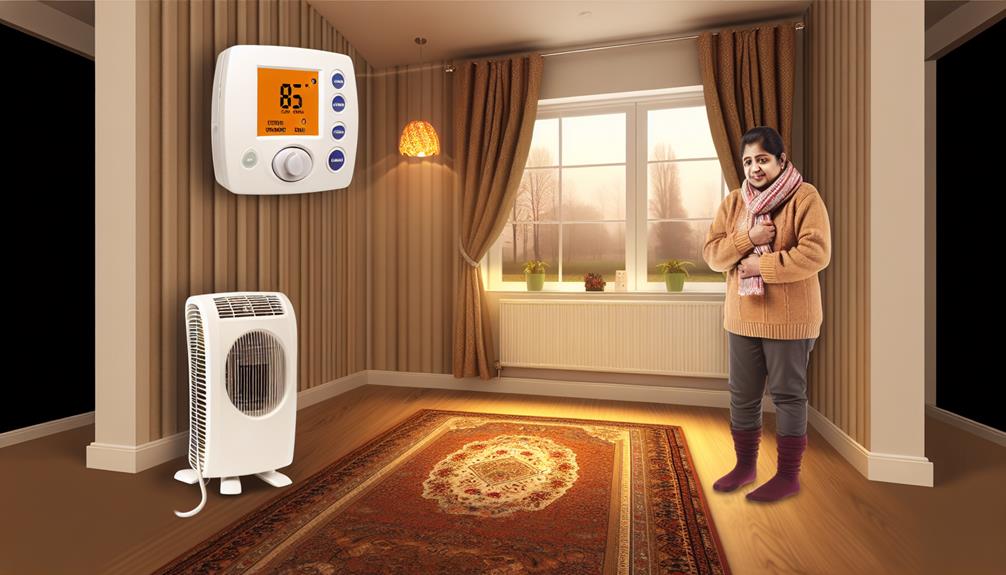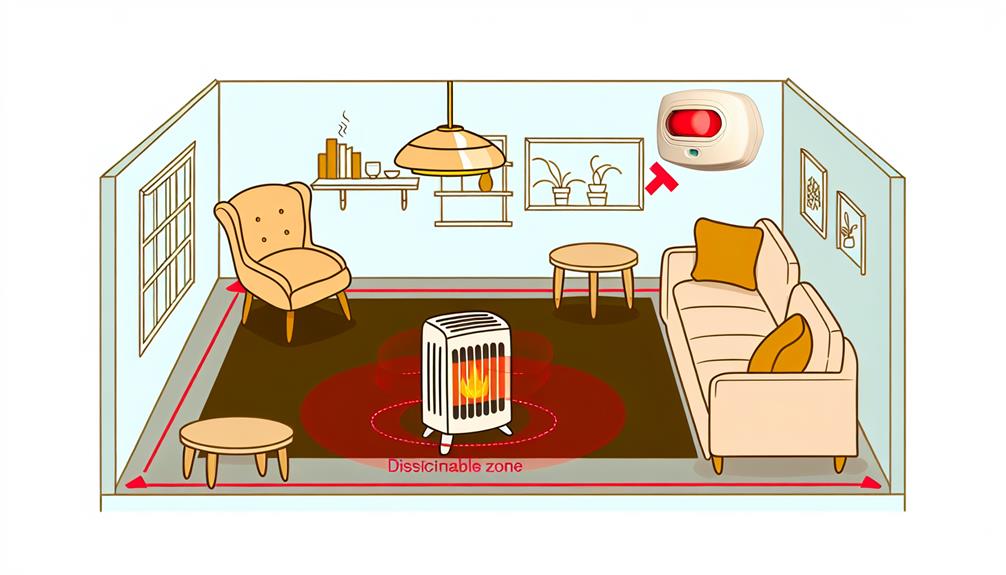In the heart of winter, your portable heater can feel like your best friend, warding off the icy fingers of cold that threaten to creep into every corner of your room. You've likely discovered, though, that not all heating strategies are created equal. To avoid the common pitfalls and get the most out of your device, you'll need to consider the size and wattage relative to the space you're heating, as well as the unit's safety features. Don't just grab any heater off the shelf; you ought to read reviews and compare models to find the one that best suits your needs. And once you've made your choice, following the manufacturer's safety guidelines isn't just recommended—it's essential. But there's more to it than just plugging in and turning on; let's explore how you can optimize your heater's performance, maintain it properly, and use it safely while keeping your energy bills in check. What might seem like small tweaks in how you use your portable heater could lead to significant improvements in both warmth and cost savings, and who wouldn't want to stay cozy without breaking the bank?
Key Takeaways
- Assess different types of heaters (convection, radiant, combination) based on energy efficiency and low environmental impact
- Prioritize safety features like tip-over switch and overheating sensors when choosing a heater
- Place the heater on a hard, level, nonflammable surface and keep it at least three feet away from combustible materials
- Use electric space heaters only as needed to supplement central heating and consider the size and wattage of the heater to match it with the space
Selecting the Right Heater
When choosing a portable heater, it's crucial to assess types such as convection, radiant, or combination units to best match your specific heating needs. Convection heaters provide a steady, even warmth by circulating hot air, making them suitable for heating entire rooms. Radiant heaters, on the other hand, deliver quick, spot heating, ideal for warming up people and objects directly in front of them without heating the entire space.
To choose the right portable electric heaters, prioritize energy efficiency to keep electricity costs and environmental impact low. Moreover, ensure the chosen model includes robust safety features. Look for a heater with a tip-over switch that automatically shuts off if the unit falls over, and overheating sensors that prevent potential fire hazards.
Heaters come with various temperature control options, from basic dials to programmable thermostats, allowing you to maintain your desired comfort level efficiently. Additionally, always verify that the heater has a respectable fire safety score and a low hot-surface score.
Lastly, safety is paramount, so confirm that the heater carries a certification mark like the ETL label from Intertek, which assures compliance with North American safety standards. This validation is not only a hallmark of quality but is also essential for your peace of mind.
Optimal Heater Placement
Having selected the appropriate portable heater, it's vital to consider its placement for maximum efficiency and safety. Optimal heater placement involves situating your space heater on a hard, level surface to prevent any potential tipping. This surface should be nonflammable to reduce the risk of fire. Ensure that the heater stands at least three feet away from any combustible materials such as furniture or bedding, which could ignite if too close to the heat source.
For homes with children or pets, it's crucial to establish a safety zone around the heater. Keep the space heater at least three feet from their reach to prevent accidental burns or tipping. This distance also applies to central heating systems and small space heaters alike.
In areas like workshops or garages, where flammable substances are commonly stored, extra caution is necessary. Position portable space heaters away from these materials to avoid fire hazards. Remember these safety tips: never leave a heater unattended, and always turn it off when exiting the room or before going to bed to conserve energy and maintain a safe environment.
Energy Efficiency Practices

To bolster energy efficiency, consider using electric space heaters only as needed to supplement central heating in frequently occupied rooms. By focusing on one room at a time, you can save energy and reduce the overall cost of heating your home. Space heaters can be expensive to operate, so it's crucial to use them judiciously.
When you're opting for supplemental heat, choose a heater with a smart sensor that automatically adjusts the temperature. This ensures the portable heater to warm the room operates only when necessary, avoiding wasted energy. Additionally, turning down the central furnace and using a space heater in specific areas can lead to significant energy savings.
For smaller spaces, a radiant space heater might be the best choice due to its direct heating capabilities. On the other hand, convection heaters are better suited for larger rooms as they distribute heat more evenly. Always check the wattage and size rating to ensure you're using the right heater for your space.
Maintenance and Care
While supplementing your central heating with a portable heater can be cost-effective, maintaining and caring for your unit is essential to ensure its efficiency and safety. Adhering to safety guidelines recommended by the Consumer Product Safety Commission helps prevent fire hazards. It's crucial to unplug your heater when it's not in use and routinely check the power cord for any signs of damage, such as fraying or cracking.
If you're using an extension cord, choose a heavy-duty one to prevent overheating. However, it's better to avoid connecting other electrical devices or extension cords to the same outlet to reduce the risk of overloading. Also, make sure your space heater has the Underwriters Laboratory (UL) mark, indicating it meets safety standards, including features like a tipover switch that automatically shuts off the heater if it falls over.
Regular maintenance and care, including inspection for malfunctions, are necessary steps to prolong the lifespan of your heater. Don't forget to install working smoke alarms throughout your home, especially on every level and in each bedroom, as an added safety measure. By following these practical and technical recommendations, you'll maximize your heater's potential while minimizing risks.
Safety Precautions

Ensuring your portable heater's safe operation begins with placing it on a hard, level, and nonflammable surface, well away from potential hazards. This simple step significantly reduces the risk of the unit tipping over and causing a fire. It's crucial to maintain a minimum 3-foot buffer zone that's free from children and pets, ensuring their safety and preventing accidental contact with the heater.
Adhere strictly to the National Fire Protection Association's guidelines, and position your heater away from any combustible materials, such as curtains, furniture, or bedding, to prevent fire incidents. Always turn off and unplug your heater when you're not in the room or before going to bed. Regular inspection of the power cord for any signs of damage is essential to avoid electrical fires.
For added safety, look for a heater with a certification from CSA, indicating compliance with established safety standards. Choose models with a built-in sensor that automatically shuts off the unit if carbon monoxide is detected or if the heater tips over. Never use an extension cord with a portable heater, as this can overheat and potentially cause a fire. Lastly, install smoke alarms and test them monthly, prioritizing safety in every aspect of heater usage.
Timer and Thermostat Use
You can enhance your portable heater's efficiency by setting the timer to switch off automatically, avoiding unnecessary runtime and potential hazards. Adjust the thermostat to maintain a steady temperature that's comfortable yet energy efficient. Learning to balance these settings not only optimizes your heater's performance but also keeps your energy bills in check.
Setting Optimal Timers
To optimize your portable heater's efficiency and safety, set the timer to automatically shut off the unit after a desired period, especially when you're not in the room or asleep. When you use a portable electric space heater, directly plug the heater into the wall and adjust the thermostat to maintain a comfortable temperature without overheating the room. Setting optimal timers ensures that the heater turns off when you leave the room, conserving energy and reducing fire risks. For each type of space, tailor the duration of heating to your needs while following the manufacturer's instructions. This practice not only preserves the longevity of your heaters but also maintains a balance between comfort, energy consumption, and safety.
Thermostat Adjustment Tips
While setting optimal timers on your portable heater is crucial for efficiency and safety, properly adjusting the thermostat further enhances energy savings and maintains your comfort. Here are some practical thermostat adjustment tips for your space heater:
- Lower the Thermostat: When you're not in the room, lower the setting to save energy.
- Timer Function: Set the timer to turn off the heater automatically, avoiding unnecessary run time.
- Comfort Balance: Adjust the thermostat to maintain a comfortable temperature without excessive energy use.
- Routine Scheduling: Use the timer to heat your space according to your daily routine, optimizing energy consumption.
Make sure the heater is plugged directly into a wall outlet to prevent potential electrical hazards. Remember, portable heaters can be expensive to use, so efficient thermostat management is key.
Energy-Efficient Temperature Ranges
How can you determine the most energy-efficient temperature range for your portable heater when using its timer and thermostat features? First, set your space heater's thermostat to maintain a room temperature near 78 degrees Fahrenheit, which is often recommended for comfort and efficiency. Utilize the timer to turn the heater on just before you return home, ensuring you're welcomed by warmth without wasting energy all day. It's imperative to never touch the heater with wet hands or place it on a power strip, as these practices can lead to house fires. Additionally, ensure the cord and plug are in good condition and that the heater doesn't provide extra heat, such as a hearth in a child's room, where a small electric blanket may suffice.
Frequently Asked Questions
How Do You Use a Space Heater Efficiently?
Did you know that zone heating can save up to 10% on your energy bills? For efficient use, set your thermostat lower and enhance insulation. Regular maintenance checks and energy audits keep your heater running optimally. Position it in a stable location away from foot traffic. Time your usage and opt for models with safety features. Choosing eco-friendly heaters further reduces your carbon footprint, making your heating both efficient and responsible.
How Can I Make My Heater More Effective?
To make your heater more effective, check your room insulation and reduce drafts. Adjust the thermostat setting for efficiency. Place your heater strategically and perform regular maintenance checks. Opt for energy-saving models that fit your space. Create a smart heating schedule, dress in layered clothing to feel warmer, and remember that higher humidity levels can help retain heat, making the room feel more comfortable.
What Are the Best Practices for Heaters?
You're aiming for optimal heater safety, so follow these best practices: Use placement tips to avoid hazards, adhere to a strict maintenance routine, and minimize energy consumption. Integrate insulation, utilize a timer, and adjust thermostat settings for efficiency. Embrace zonal heating to focus warmth where it's needed, ensuring even heat distribution. Stick to these guidelines to keep your space cozy and safe.
What Is the Most Efficient Form of Portable Heating?
The most efficient portable heating relies on your room's size and needs. Infrared technology suits small areas, directly warming people and objects, while ceramic convection heaters excel in larger spaces by evenly distributing heat. Oil-filled radiators offer sustained warmth. Prioritize energy efficiency to reduce your carbon footprint. Seek heaters with safety features, programmable thermostats, and heating capacity that matches your space. Eco-friendly options also contribute to a greener lifestyle.
